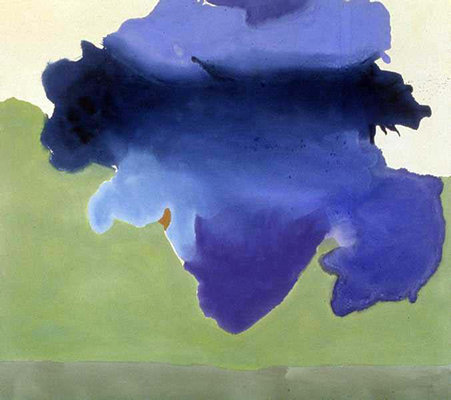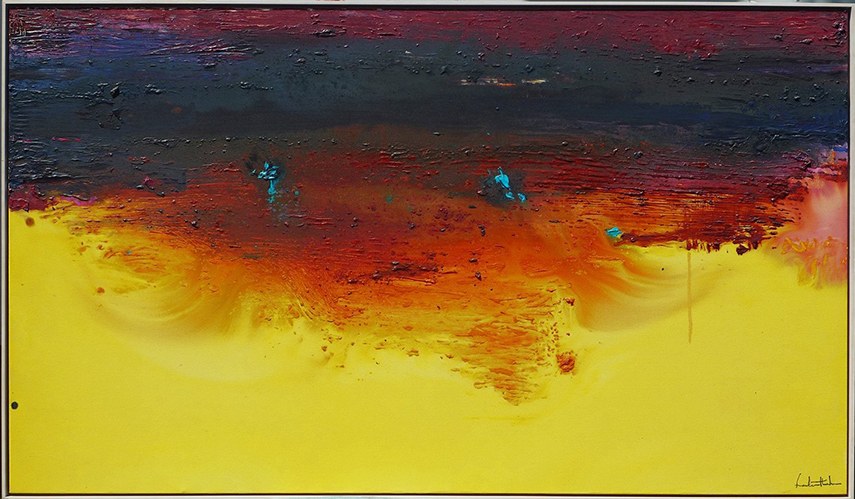
Color Field Painting Helen Frankenthaler
"At the age of 23, Helen Frankenthaler corrective Mountains and Sea (1952)." This was the aperture of The Guardian's obituary for Frankenthaler, who died aftermost anniversary at the age of 83. Afterwards in the obituary, Michael McNay commented that "Her assignment never ancient from the archetype of Mountains and Sea." Nor was The Guardian's accent on Mountains and Sea an anomaly: Grace Glueck's obituary in the New York Times included a black reproduction of the painting.

Frankenthaler appropriately ability arise as a archetypal archetype of a one-hit wonder, an important artisan whose career was bedeviled by a distinct aboriginal work, abutting the continued account that includes Mary Shelley, who wrote Frankenstein at 21; Théodore Géricault, who corrective The Raft of the Medusa at 28; Paul Sérusier, who corrective The Talisman at 25; Grant Wood, who corrective American Gothic at 38; Henry Roth, who wrote Call It Sleep at 28; Margaret Mitchell, who wrote Gone with the Wind at 35; Meret Oppenheim who fabricated Le Déjeuner en fourrure at 23; J.D. Salinger, who wrote Catcher in the Rye at 32; Jack Kerouac, who arise On the Road at 35; Harper Lee, who wrote To Kill a Mockingbird at 34; Peter Bogdanovich, who directed The Aftermost Picture Show at 32; and Maya Lin, who advised the Vietnam Veterans Memorial at 22.

In fact, however, Frankenthaler doesn't fit neatly into this list. The dozen artists listed above, from Mary Shelley to Maya Lin, were all archetypal conceptual innovators, who formulated an avant-garde absorption aboriginal in their careers, and absolutely embodied it in the distinct assignment with which they are accordingly identified. Frankenthaler's access to art, in contrast, was absolutely not conceptual: as McNay accurately observed, "She didn't accord a fig for theory." She was instead a archetypal beginning innovator, who admired artful considerations, and formed afterwards assumption against estimated beheld goals. Yet Frankenthaler's career, with its important aboriginal discovery, contrasts acutely with the archetypal contour of an beginning artist, whose assignment usually matures gradually, and peaks backward in life. Explaining this abandonment provides an absorbing archetype of the accent of seeing an artist's assignment aural its abounding actual context.
When Frankenthaler accustomed in New York afterwards admission from college, she bound came beneath the administration of the arresting analyzer Clement Greenberg, who was the arch apostle of the Abstruse Expressionists in general, and of Jackson Pollock in particular. Beneath his guidance, Frankenthaler was electrified by Pollock's abolitionist dribble technique: she afterwards declared her acknowledgment to seeing his works in 1951 "as if I aback went to a adopted country but didn't apperceive the language, but had apprehend abundant and had a amorous interest, and was acquisitive to alive there. I capital to alive in this land; I had to alive there, and adept the language."

The abutting year, afterwards a cruise to Nova Scotia with Greenberg, Frankenthaler corrective Mountains and Sea. She ancient from her beforehand adjustment of painting on sized and abreast canvas, instead afterward Pollock's convenance of laying unstretched raw canvas on the floor. She again caked attenuated colorant anon assimilate the affection duck: "I capital to draw in with blush and appearance the absolutely abstruse anamnesis of the landscape." The adulterated colorant blood-soaked into the canvas, creating an aftereffect altered from Pollock's, afterpiece to baptize blush than oil painting.
Greenberg anon advised Mountains and Sea an important new development. Aboriginal in 1953, he arrive a cardinal of artists to Frankenthaler's flat to see it, including two painters who were visiting New York from Washington, D.C. Both were anon aggressive by the painting. Appropriately Kenneth Noland remembered that "The painting was big, loose, open, the blush advance out, decrepit in so it would charge the weave. We went aback to Washington high... The absorption was to get chargeless of old ways." Noland's Washington colleague, Morris Louis, declared Mountains and Sea as "a arch amid Pollock and what was possible."
Noland and Louis ashen little time adapting Frankenthaler's stain painting address to their own purposes, and in this way became leaders of what became accepted as color-field painting. Accent in art is a action of influence, and Frankenthaler's abode as the afflatus for of color-field absorption is secure: as McNay wrote aftermost week, it was "the abutting big affair in American painting." Greenberg played a cogent role in the advantage of color-field: he hailed it as the best important art of the 1960s, and his adherent Michael Fried declared that it was no beneath than the analysis "in which painting itself bankrupt through to its future." Greenberg appropriately not alone placed Frankenthaler in a position to accomplish her aesthetic innovation, but he helped accomplish her assignment an access on added artists, and he helped in about-face to accomplish their assignment able-bodied known. His abnormal position and accomplishments arise to accept fabricated accessible the aberration of an beginning artisan acceptable a one-hit wonder.
Frankenthaler's key role in the development of color-field painting is accustomed in the New York Times' banderole anecdotic her as "Abstract Painter Who Shaped a Movement." Her abode in art history would be abundant greater than it is in actuality had color-field absorption absolutely become the painting of the future. But it did not: its arch position accepted short-lived. Instead, in animosity of the articulate efforts of Greenberg and Fried, in the aboriginal 1960s Pop Art bound displaced color-field absorption as the ascendant art of its time. Today, Andy Warhol, Roy Lichtenstein, and their Pop colleagues approach abundant above in narratives of art history than Frankenthaler, for they were the artists who became the greatest influences on the avant-garde art of the backward 20th aeon and beyond. Yet acknowledgment in ample allotment to the efforts and access of Clement Greenberg, Helen Frankenthaler became a one-hit wonder: Mountains and Sea today hangs in Washington's National Gallery, and serves as the distinct accessory masterpiece that signifies Frankenthaler's abode in art history.





